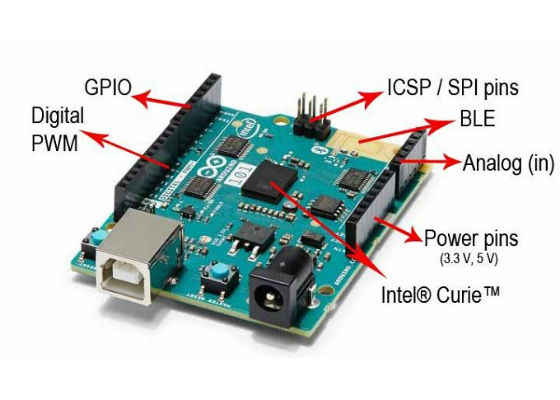Arduino: what why and how
What is Arduino?
Arduino is an open-source electronics platform based on easy-to-use hardware and software. Arduino boards are able to read inputs – light on a sensor, a finger on a button, or a Twitter message – and turn it into an output – activating a motor, turning on an LED, publishing something online. You can tell your board what to do by sending a set of instructions to the microcontroller on the board. To do so you use the Arduino programming language (based onWiring), and the Arduino Software (IDE), based on Processing.
https://www.arduino.cc/en/Guide/Introduction
Why Arduino?
The Arduino software is easy-to-use for beginners, yet flexible enough for advanced users. It runs on Mac, Windows, and Linux. Teachers and students use it to build low cost scientific instruments, to prove chemistry and physics principles, or to get started with programming and robotics. Designers and architects build interactive prototypes, musicians and artists use it for installations and to experiment with new musical instruments. Makers, of course, use it to build many of the projects exhibited at the Maker Faire, for example. Arduino is a key tool to learn new things. Anyone – children, hobbyists, artists, programmers – can start tinkering just following the step by step instructions of a kit, or sharing ideas online with other members of the Arduino community.
https://www.arduino.cc/en/Guide/Introduction
How do I use Arduino?
See the getting started guide. If you are looking for inspiration you can find a great variety of Tutorials on Arduino Project Hub.
++++++++++++++++++++++++
Just What Is An Arduino, And Why Do you Want One?
https://www.wired.com/2008/04/just-what-is-an/
CHARLIE SORREL.CHARLIE SORREL DATE OF PUBLICATION: 04.15.08.
++++++++++++++++++++
introduction to the work with Adruino and ideas for projects:
https://learn.sparkfun.com/tutorials/what-is-an-arduino
+++++++++++++++++++++++++++
Genuino Uno Rev3 (Arduino Uno Rev3)
https://www.iot-store.com.au/products/genuino-uno-rev3-arduino?variant=29111078023
+++++++++++++++++++
The Basics of Inputs and Outputs, Part 2: Understanding Protocols
http://www.digit.in/apps/the-basics-of-inputs-and-outputs-part-2-understanding-protocols-32154.html
The Arduino board has a dual-core x86 32-bit Intel® Quark™ processor, which allows for multithreaded applications and enables the use of powerful peripherals that the UNO board did not support. The board’s operating voltage is 3.3 V input/output (I/O), with 5 V tolerance, meaning that you can also connect 5 V components. It has 20 general-purpose I/O (GPIO) pins: 14 digital I/O pins and 6 pins for analog-to-digital conversion (ADC). It is equipped with four pulse width modulation (PWM) pins and three channel logic converters connected to the GPIO pins. The Arduino 101 board has an in-circuit serial programming header with serial peripheral interface (SPI) signals that you can use to access microcontrollers and I2C dedicated pins. With a built-in six-axis accelerometer, gyroscope, and Bluetooth* low energy (Bluetooth* LE), you can easily create Internet of Things (IoT) apps that allow you to use your smartphone to control your board (Figure 1).

read more here
++++++++++++++++++++++++++++++++
Dog Treat Dispenser
http://www.instructables.com/id/Dog-Treat-Dispenser/
++++++++++++++++++++++++++++++++++++++++
Arduino Basics: Transistors for Robotics
https://www.hackster.io/glowascii/arduino-basics-transistors-for-robotics-2cf124
+++++++++++++++++++++++++++++++++++++++++
For the love of Arduino -Getting Started
